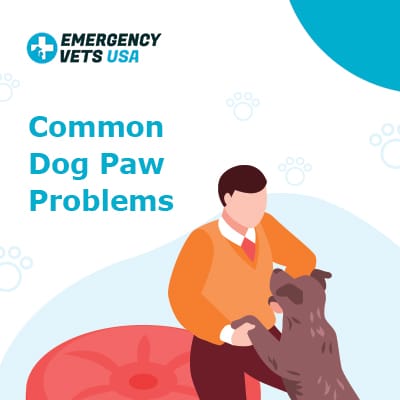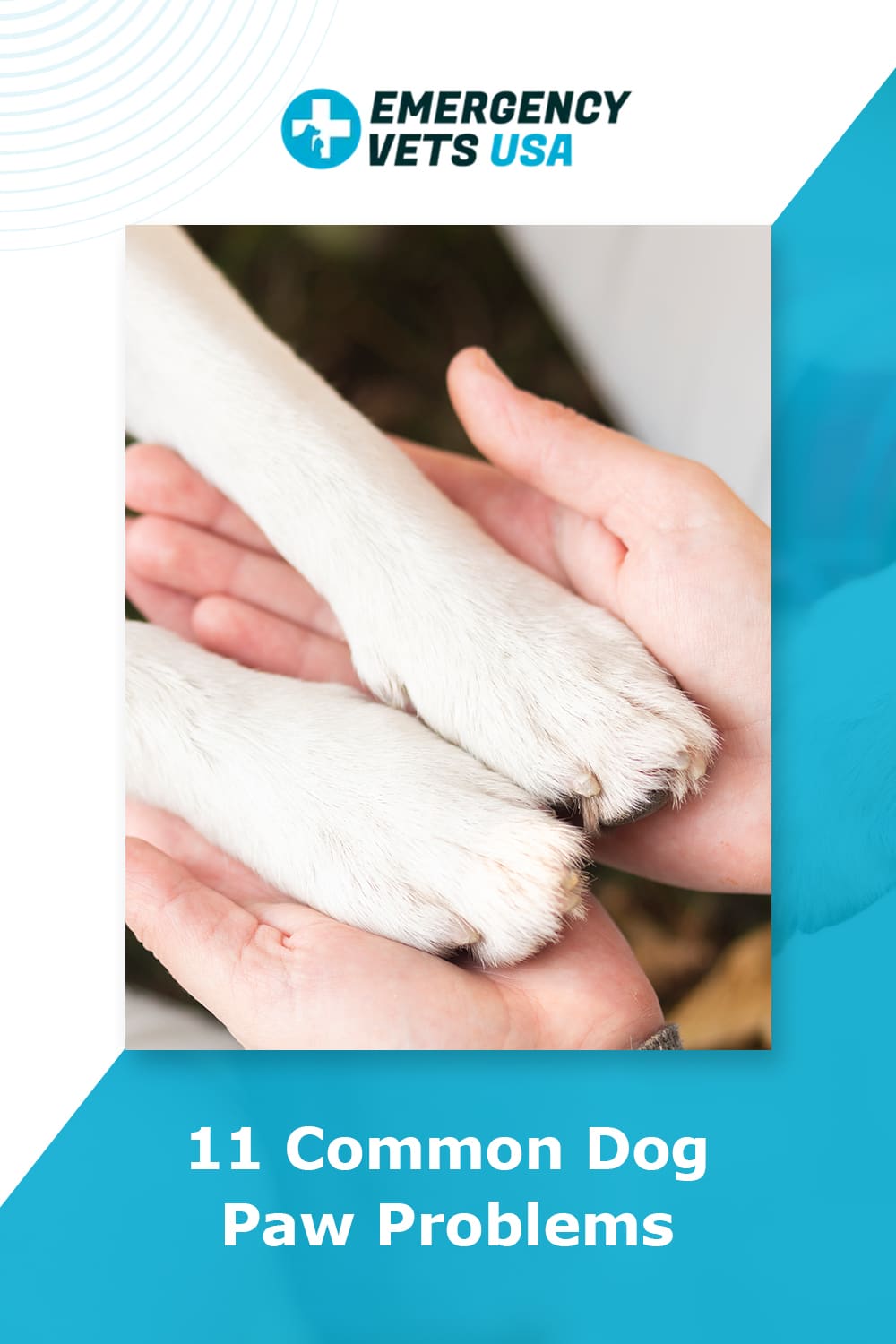11 Common Dog Paw Problems
What to Watch Out for and How to Treat Them
Your dog’s paws are incredibly important to them.
They use them on a daily basis to walk, run, jump, and play.
In fact, if something is wrong with one of your dog’s paws, it can severely impact their quality of life.
It can be easy to overlook most dog paw problems because you probably are not checking their feet daily.
You most likely won’t notice anything until you see your dog limping or excessively licking or chewing at their feet.
In this article we will discuss some of the more common causes of paw problems in dogs, what to watch out for, and how they are treated.
How To Know If Your Dog’s Paw Hurts

Some dogs are very stoic and will not give any indication something is bothering them until it becomes too difficult to hide.
If you know your dog well, you should be able to pick up on some subtle signs they are having problems with a paw.
Here are some signs your dog’s paw or paws may be bothering them:
- Licking and/or chewing at their paw
- Brown discoloration to the fur on their paw (indicating they have been licking their paw even if you haven’t seen it happen)
- Hair loss on or around their paw
- Holding a paw up
- Limping
- Bleeding from the paw
- Redness on or in between the toes
- Seeing ulcers, lesions, or discharge in or around the paw
- Swelling of the paw
If you notice any of these signs, see if your dog will allow you to examine their paw.
Some dogs may not let you look at their paw if it hurts too much. You will need to schedule an appointment with your veterinarian to have your pup’s paw examined.
They will be able to determine what is going on and and to provide the best treatment.
The following is a list of the most common causes of paw problems.
How they are diagnosed and how they are treated.
Causes & Treatments Of Paw Problems
There are various causes of paw problems in dogs, some of which are easily fixable.
Others may need more extensive diagnostics or drastic treatments, though those are usually not as common.
Your veterinarian can help you get to the bottom of your pup’s paw problem and work with you on a treatment plan.
1.) Allergies & Sensitive Skin
Believe it or not, allergies are the most common reason dogs have problems with their paws.
Dogs with allergies are often very itchy in between and underneath their toes.
Especially when they are resting, they will lick and chew at their toes.
This can often lead to pain and worsening inflammation and redness in between their toes and paw pads.
If you notice your dogs paw is red, this could be a sign of an allergy.
How To Diagnose Allergies And Sensitive Skin
Your vet will usually diagnose the cause as being due to allergies based on physical exam and your description of the problem.
They may take a small sample of cells from the surface of your dog’s paw to look at under a microscope to help rule out other conditions.
How To Treat Allergies And Sensitive Skin
Treatment will typically involve medication to alleviate your pet’s pain and itch.
Your vet may also prescribe special medicated wipes to use on your pup’s paws a few times a day.
If you suspect your pet is licking their paws due to allergies, try to remember to wipe their paws off with a damp rag or towel every time they come in from being outside.
This can help take off any pollen that is lingering in their fur that may contribute to their itchiness.
Remember, your dog is essentially running outside ‘barefoot’. Their feet are touching the ground and if they have any type of allergy, it can easily flare up.
2.) Yeast Infections
Your dog’s skin is naturally composed of some yeast organisms.
It is when these yeast overgrow and multiply too much that they begin to cause a problem for your dog.
Yeast infections in dogs’ paw pads are very common.
The yeast will take advantage of any underlying inflammation in your dog’s paws, such as due to allergies, and wreak havoc.
If your dog has a yeast infection, you may notice a foul, yeast-like odor coming from their paws, redness, hair loss, or a brown discoloration to their fur from them licking that area.
The skin in between their paws may also be somewhat moist.
How To Diagnose Yeast Infections
Your vet will take a small sample of the cells in between your dog’s toes and look at that under a microscope.
They can see the little yeast organisms microscopically – they actually look like tiny versions of the peanut man!
How To Treat Yeast Infections
Yeast infections are treated with either an oral or topical anti-fungal medication.
Your vet will also likely prescribe a medication to help alleviate your pup’s itch.
If this is the cause of your dogs problem, medication will quickly fix it.
3.) Bacterial Infections
Just like with yeast infections, bacterial infections are often caused by the normal bacteria living on you dog’s skin that begins to over populate.
Your dog may also develop an abscess in between their toes if they get a minor injury that becomes infected.
You may notice swelling, redness, or foul-smelling discharge in the paw.
You may also notice your dog excessively licking that area.
How To Diagnose Bacterial Infections
Your vet can take a sample of the discharge to evaluate under a microscope to see what type of bacteria is causing the problem.
Depending on the severity, they may also need to send out a bacterial culture to make sure your dog gets on the correct antibiotic to treat the infection.
How To Treat Bacterial Infections
Antibiotics will be prescribed to treat the infection.
Your vet may also recommend you put an E-collar on your dog to prevent them from making the infection worse.
Depending on your dog’s pain level, pain medications may also be prescribed.
4.) Foreign Objects
Occasionally, a dog may get something stuck in their paw.
This usually happens if they are running around outside, getting a splinter or possibly a nail stuck on their paw.
If this happens, your dog will likely be limping and favoring their paw.
How To Diagnose Foreign Objects
This can oftentimes be diagnosed with visual inspection only.
However, an x-ray or even ultrasound of the paw may be needed if the object isn’t directly visual.
In some cases, where a foreign object is suspected, but it cannot be seen even on x-rays, your vet may recommend an “exploratory surgery” to find the object and remove it.
How To Treat Foreign Objects
Remove it!
Sometimes this is easier said than done.
Superficial foreign objects may be able to be removed by gently pulling them out.
Others will need extensive surgery, with your dog under anesthesia, to find and carefully take them out.
If the object is big or you do not feel like this is something you can take out, then call your local veterinarian.
5.) Torn Toenails
Torn toenails are very common in dogs.
Your dog can easily get a toenail stuck in carpet or other fabric, and in the process of tugging to get it unstuck can rip it off.
Dogs who love to dig in dirt can also tear a toenail.
The toenail that is most commonly torn is the dewclaw (that’s the claw that hangs from higher up on their leg) because it is off to the side and fairly loose.
Any of your dog’s toenails are at risk of being torn.
How To Diagnose Torn Toenails
Visual inspection will let you know if this is the problem.
How To Treat Torn Toenails
This will depend on the degree of the tear.
If the toenail is very loose and just hanging on to the quick (the nerve and blood supply to the toenail), your vet can use hemostats to firmly and quickly pull off the loose toenail.
If the toenail is torn but still adhered strongly to the quick, your vet may just trim the torn toenail back as far as they can.
They may apply a light bandage around the paw to keep it clean and to prevent your dog from licking at it.
Pain medications are also useful as torn toenails can be quite painful.
Keeping your dog’s toenails trimmed on a regular basis can help prevent them from getting torn.
6.) Ingrown Toenails
Ingrown toenails occur if your dog’s nails are allowed to grow too long.
The nails will curl around, and begin to puncture your dog’s digital pads.
This more commonly occurs with the dewclaw since it does not ever come into contact with the ground.
This is mostly a problem for small dog breeds and elderly dogs who already have difficulty getting around.
How To Diagnose Ingrown Toenails
Visual inspection to look for a toenail that is curved with the tip stuck inside one of your dog’s pads.
If your dog does not allow you to inspect the underside of their paws, your vet will need to examine them for you to help with the diagnosis.
How To Treat Ingrown Toenails
Cutting the toenail. This often involves you or your vet cutting the toenail where it curves, then pulling the ingrown toenail out of the pad.
Antibiotics will be needed to prevent or treat infection. Pain meds will be needed to help with your dog’s discomfort.
If the puncture in the paw pad is severe, a light bandage may need to be applied for a few days as well.
7.) Toe Fractures
Though rare, dogs can definitely break their toes.
This usually happens as a result of a traumatic event, such as getting their paw stuck in something and tugging vigorously to get it out, getting stepped on, or having something fall on their foot.
Dogs with toe fractures will not put weight on their paw, may have a swollen paw, and may lick at their paw often.
How To Diagnose Toe Fractures
An x-ray will be needed to look at the bones of your dog’s toes.
How To Treat Toe Fractures
Depending on the location of the fracture, either a splint or a very thick bandage will be needed while the fracture heals.
Fractures usually take about 8-12 weeks to heal, so be prepared for regular bandage changes and trying to keep your dog rested and calm during the healing process.
8.) Burns
If your dog loves to go hiking or on long runs with you, make sure to inspect their paws during and after every outing.
Dogs who love spending time doing activities with their owners may not give any hint that their paw pads are getting burned from the hot ground or irritated from the constant motion.
How To Diagnose Burns
Visual inspection of the paws and paw pads. They may look red and irritated, or the paw pads may be dry and cracked.
How To Treat Burns
Rest. Rest your dog and keep them off of their feet for a few hours.
You can also apply some Vaseline to the paw pads. If the paw pads appear very irritated, you may check with your veterinarian on whether they recommend antibiotics or any additional treatment.
9.) Injuries – Cuts, Scrapes, and Lacerations
It is very easy for dogs to get cuts, abrasions, scrapes, and lacerations on their paws.
Just from running around outside, they could get cuts from sticks, rocks, and rough grass.
If there happens to be glass lying around they can easily get large cuts and lacerations in their paws and paw pads.
How To Diagnose Injuries
If you suspect your dog has a cut under their paw and you see blood, you should take them into your vet right away.
If your dog has pain or is anxious, your vet can give them a light sedative so they can safely and adequately trim away any fur.
This will allow your veterinarian to look at the injury and find the right treatment.
How To Treat Injuries
Minor cuts and scrapes may just require disinfecting, a light bandage, antibiotics, and pain medications. Deeper or larger lacerations will require stitches.
10.) Cancerous and Non-Cancerous Growths
Dogs can develop growths and cysts all over their body, even on their paws and in between their toes.
Many of these growths and cysts are benign in nature, meaning that other than being a nuisance they will not affect your dog’s health.
However, some of them can be malignant (bad) cancers that are serious to deal with.
There are many different types of bad cancers that can affect the toes of dogs, but the most common ones are Squamous Cell Carcinoma and Malignant Melanoma.
How To Diagnose Growths
If you see a growth on your dog’s paw or in between their toes, your vet will need to take a “cytology sample” of the growth.
They will do this by poking the growth with a small needle to collect cells. They can then look at these cells under a microscope.
If a diagnosis is unable to be determined using this method, your vet may recommend sedating your dog to take a biopsy of the growth.
A biopsy is where they cut out a portion of the growth to send to a lab. Alternatively, depending on the size of the growth, your vet may even just recommend removing the entire thing for a full diagnosis.
If it is suspected that the growth is cancerous, an x-ray may also be needed to look at the bones of your dog’s toes to see if the bones have been invaded by cancerous cells.
A chest x-ray may also be recommended to make sure the cancer has not already spread elsewhere in your dog’s body.
How To Treat Growths
If the growth is determined to be a benign tumor, you can either elect to leave it be and ignore it, or you can have it removed surgically.
Removing it surgically would be wise while it is small because if it does get bigger, it can start to cause more discomfort for your dog.
The bigger the growth the more problems that can arise with their ability to walk normally.
If it is a bad type of cancer, your veterinarian will discuss with you options going forward.
These may include surgery to remove the growth, amputation of the affected toe, and/or chemotherapy.
11.) Autoimmune Conditions
There are certain autoimmune conditions that specifically affect dog’s toes.
The most common one is Lupoid Onychodystrophy.
It affects dog’s toenails, causing them to break, crack, and even fall out. It can be quite painful and sometimes difficult to get under control.
While it is more likely to affect German Shephard Dogs, any breed of dog can develop it.
Once a dog is diagnosed with it, they will have the condition their entire lives. There are medications that can help keep it under control.
How To Diagnose Autoimmune Conditions
Your veterinarian will often make the diagnosis based off of physical exam and your description of the problem.
For a confirmatory diagnosis, your vet may need to perform a biopsy.
This is a procedure during which your dog would need to be sedated and a tissue sample from their toe will be cut out and sent to a laboratory for examination.
How To Treat Autoimmune Conditions
Treatment involves a combination of factors, including regular nail maintenance and various medications.
Your dog’s nails should be trimmed at least every 2 weeks and any loose nails that are causing your dog problems should be removed manually.
Medications include omega-3 fatty acids, vitamin E, Niacinamide, Pentoxifylline, and an antibiotic called Doxycycline.
In some cases, steroids or other immunosuppressant medications may need to be used as well.
Since this disease process is thought to be caused by an over reactive immune system, dogs with Onychodystrophy should limit the number of vaccines they are given.
Your vet can make recommendations for your dog based on their lifestyle and risk factors.
Final Thoughts On Paw Problems
Check your dog’s paws often!
Don’t forget to inspect their paws daily to make sure they look good and healthy.
After all, your dog depends on them to get around! If you see something you are worried about, contact your vet’s office to schedule an appointment and have it evaluated.


Leslie Brooks graduated from the University of Tennessee College of Veterinary Medicine in 2012. After graduation she moved to Indianapolis to do an intensive one-year internship at a specialty practice and then began working as a small animal general practitioner. She ran her own house call practice for three years, visiting pets in people’s homes. Currently, she works part time in clinical practice and volunteering her free time to serve pets of the homeless. Read more about us here.
